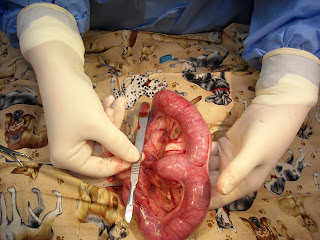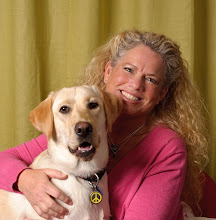
So, the picture is a little blurry, but that is because little miss Raena was moving pretty darned fast. That big silver disc she is on is actually her exercise wheel, a pretty great design, considering most of the ones you usually see for rodents are made of open wire, and an open wire wheel caused Raena a huge problem a few years ago. She got hung up in it somehow (she wasn't telling exactly what happened) and broke her tiny little leg. We tried to fix it, but rodents aren't known for being the best patients when it comes to injuries like that, and Raena the chinchilla was no exception. Chewing at wounds and suture lines, and not understanding the meaning of "rest" or "taking it easy" until the bone could heal meant numerous complications, and she ended up having her left hind leg amputated. Not that you would ever know that today. She may have a goofy little swing to her gait, but when she gets going on her nice solid wheel, she looks like a pro! And boy, is she fast! We had her out in the living room the other night just to see her scamper around. When it was time to put her to bed-ha! it was crazy trying to catch that slippery little varmint! It really does my heart good to see how lively she is-don't even dare consider this girl "handicapped." A 3-legged chinchilla is just the most natural thing in the world, at least it is in a vet's home!
My husband Michael and I lost our first chinchilla, Edgar, last year. He was over 15 years old-quite a distinguished old man, and such a wonderful little pet. I don't think we realized just how much we had missed him until we learned that Raena's owner was asking about finding her another home. My hospital manager, Cori, had owned one of Raena's babies at one time, and she would have made a great home for her. But she has a very happy chinchilla already, and she didn't want to risk upsetting the balance of his life by adding another critter right now. I jumped at the chance to add Raena to our little family, and she came home with me last Friday.
You would think she would take some getting used to her new situation, needing some time to figure things out and all but, no, not Raena. She never missed a beat, jumping out of her travel carrier right onto her exercise wheel and going for a short run right when she arrived. Then she hopped over to the side of the cage and took a raisin from Michael-he was thrilled! It was one of Edgar's favorite treats, and now you can be sure she will be spoiled rotten by her new "dad." Raena wasn't even phased by the cats who came running over to see who was taking occupancy of the great big cage in the living room-they were pretty perturbed it wasn't for them! Anyway, Raena didn't even bat an eye at those natural predators, or maybe she was batting her eyes, winking and flirting, more like teasing those cats who are easily 6 or 7 times her weight!
Chinchillas are members of the rodent family, actually closely related to porcupines if you can believe that!, but also related to guinea pigs.
Yes, chinchillas were originally bred in captivity for their pelts-it
IS wonderfully luxurious and beautiful, but it seems to me it would take an awful lot of those little guys to make a single coat! Current fur colors we see include white, silver, beige, and black. The chinchillas who were lucky enough to have lower quality fur were sold as pets, although some were used as research animals. That is how I got my first chinchilla, Edgar-he was losing all of the fur on his body, not exactly what they wanted in the fur-coat business, thank goodness! He was a wiley little dude-he grew a gorgeous thick silver coat after he came to live at our home and was no longer at risk of being made into a coat.
Chinchillas originated in the barren, mountainous regions of Peru, Bolivia, Chile and Argentina-particularly in the high altitude Andes mountains. The first known chinchilla ranch was founded in Chile in 1874 in Vallenar by John Murry, an English member of the famous scientific expedition "Challenger." In February 1923 an American mining engineer, Mathias Chapman, brought the chins to North America. He was in charge of several mines in the Andes and that is where he was introduced to the chinchilla. He took an immediate liking to the little guys and hoped that he could take a few of them home to California as pets. The export of chinchillas was illegal, however, he eventually persuaded the authorities to permit him to take eleven chins with him back to the States. Eight male and three female Chinchilla Lanigeras. He brought them down from the mountains and arranged passage on a Japanese freighter. And the story goes, (although this is almost certainly apocryphal) that all the chins in North America are descended from Chapman's.
In general, chinchillas are very friendly and clean little pets, and compared to most pet rodents, have very little odor. They can be quite shy and high-strung and therefore easily frightened, so they aren't the best pets for small children. It can be difficult to house multiple chinchillas in one cage, even in larger cages, especially if you have a more aggressive female chinchilla. Breeders and pelters have an interesting arrangement for their habitats to avoid "disagreements." They will create polygamous colonies with one male having access to five or so females maintained in separate cages. The male has a tunnel along the back of the females' cages which enables him to enter any cage at will. The females cannot pass through the tunnel because they are fitted with light-weight collars that are just a little wider than the cage opening.
Chinchillas are best housed in large, wire-meshed cages for proper ventilation, with or without a solid floor. They need some sort of enclosed nesting box to sleep in. They tend to be nocturnal creatures, spending a lot of time running around, eating and playing while YOU are sleeping-so be sure to oil that squeaky exercise wheel! Wood cages aren't a good idea because chinchillas are constant chewers, and pretty quickly your nice wooden cage will be a pile of saw dust! Ideal environmental temperatures are around 60 to 75 degrees F.

Raena has been fed a very good, balanced diet-but that isn't the case for a lot of the pet chinchillas we see. In fact, improper nutrition and/or husbandry (housing and care) are the most common causes of health problems in our little rodent and other small pets. She gets a pelletted chinchilla diet, although not all pet stores or feed stores will carry this. Using a standard rabbit or guinea pig ration is OK temporarily. Chinchillas like Raena are really cute when they eat, tending to pick up each pellet with their little hands, but they can be pretty messy, too, throwing a lot of pellets around the cage, so there can be quite a lot of waste. Raena has been pretty neat about her eating habits so far.
Grass hay is an important part of a chinchilla's diet as it adds fiber, important for proper digestion and teeth wearing (chinchilla's teeth grow constantly through their lives so need to be monitored for problems associated with overgrowth.) Hay also just gives these little guys something to do. Bored chinchillas often start to "barber" or chew on themselves, and many become bald as Edgar almost did. Alfalfa hay has the wrong calcium/phosphorus ratio for proper chinchilla nutrition, so should be avoided. Any hay fed to them should be clean with no evidence of mold, insects, or wild rodent contamination.
I mentioned earlier that Raena loved the raisin that Michael gave her. Dried fruit and nuts are great treats for chinchillas-and these little guys really do look like they are just relishing those treats! Fresh veggies are great, too, but all these treats should only be about 10% of the total diet. Because of their original habitat, dry, barren mountainous regions, chinchillas aren't used to taking in lots of fluids like what is found in fresh produce. They will likely drink much less water if they are offered these fresh treats, but their urine output should remain about the same. Be sure to monitor this for any changes or problems. Raena has a wonderful plastic corner box which she uses as a litter box. I just take that out and rinse it out every other day or so-it really cuts down on the need for an over-all bedding change in her cage. Pretty cool, huh?
One unique part of chinchilla husbandry is the need to offer them a dust bath a couple of times a week. Raena LOVES hers! She takes her dust bath in a little plastic box, big enough for her to twist and turn and spin all around, covering herself from head to tail with the lightly colored powder. When she is done all you can see are her two little eyes peeking out of all that powdered fur. The dust is actually a finely ground volcanic ash, and it serves to keep that wondeful fur clean, oil free and over all well groomed. I think it is just plain fun for them to spin around in the bath! Here's a good You-tube video of a chinchilla enjoying his bath:
Chinchilla Dust BathI don't leave the bath in the main cage all the time or it gets used as a litter box...and then it isn't much good as a grooming aid.
Raena is a pretty tame chinchilla, but she still doesn't like being handled all that much. In general, chinchillas are usually easy to handle and rarely bite (although any little critter can if agitated enough.) More likely, they might just urinate when they are annoyed about being held-so watch out! You also have to be gentle when handling chinchillas due to the possibility of 'fur slip." This is a sudden shedding of the hair coat in a patchy way that occurs when it is grasped or handled roughly. I haven't ever seen this happen-and I hope I don't! Doesn't 'fur slip' sound awful? As with any animal, just be gentle but firm when holding or restraining a chinchilla to avoid injuries to you or them.

The average life span for a pet chinchilla is 8 to 10 years, but there have been reports of some reaching 18 years! Raena is 6 years old right now, so she should have a good long life ahead of her-I sure hope so! She has already brought a lot of joy to our home, and I am so very grateful to her first owners for letting us adopt her into our family. I have been playing around with how her name is spelled, and even if we should keep her name as it is since it is so darned close to my own. I found several different definitions for her name, including "queen," "pure," and "song." We'll see how things work out. For now, our "pure little song queen" is working her way into our hearts....it isn't taking long to accomplish that!
Peace,
DrReneigh







































